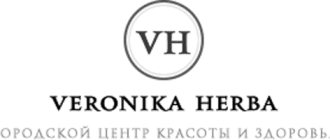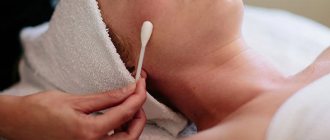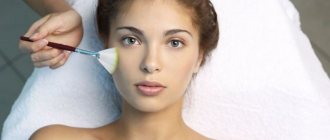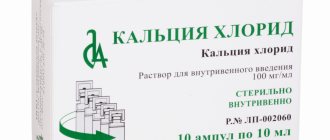The essence of enzyme peeling
This term refers to surface peeling, in which the role of the active elements is performed by enzymes, not acids. This manipulation produces a rather gentle effect on the skin. It is suitable for all types of dermis. Therefore, the technique is recommended even for those with sensitive epithelium with rosacea.
The principle of such peeling is aimed at gently cleansing the epithelium of dirt, dead cells and secretions. Thanks to this type of manipulation, the skin becomes smoother and acquires a beautiful shade. After the procedure there is no need for restorative procedures or specific care. It does not cause redness or peeling.
Peeling is a good solution for those with young skin. It has pronounced cleansing, protective and moisturizing properties. The procedure can be used for women with aging skin. Thanks to this, it is possible to activate regeneration processes. Enzyme peeling will help restore lost tone and improve the shade of the dermis.
In addition, the procedure successfully copes with age spots and acne. It can be used if you are prone to allergies and inflammatory processes. The manipulation is also suitable for women who suffer from rosacea or rosacea.
Advantages and disadvantages
The key advantages of the procedure include the following:
- Soft impact. If you compare this type of peeling with the effect of fruit acids, you can achieve a more gentle effect. Enzymes cause less damage and irritation to the skin.
- Weakening of hair follicles. The procedure helps slow down facial hair growth.
- Possibility of use at different times of the year. This peeling can be done without taking into account sun activity. Moreover, it is suitable not only for the face, but also for other parts of the body.
- No abrasive elements in the composition. Due to this, peeling has a gentle and superficial effect. Therefore, the product can be used even for rosacea and a tendency to allergies.
- The procedure can be performed if you are overly sensitive to alpha hydroxy acids or have no effect from other types of peeling. The manipulation can also be carried out during pregnancy and breastfeeding.
- Quick effect. The procedure does not take much time and provides quick results. Subsequently, there is no risk of painful recovery or severe peeling of the dermis.
- Possibility of use at home. On sale you can find many ready-made cosmetics that allow you to carry out enzyme peeling.
After peeling, it is possible to reduce pores and cope with post-acne symptoms. The procedure increases the tone of the dermis and improves its relief. With its help you can cope with fine wrinkles, moisturize the epithelium and make your face look fresher.
At the same time, enzyme peeling also has certain disadvantages. These include the following:
- The need for several procedures. This allows you to achieve a more noticeable effect.
- Deterioration of the dermis. This occurs when the required number of procedures is exceeded.
- Inability to eliminate serious defects. Enzyme peeling does not help eliminate severe pigmentation, deep wrinkles, and severe post-acne.
- Risk of side effects. During the procedure, aggravation of acne may occur. Also, this type of peeling can provoke symptoms of allergic and seborrheic dermatitis.
Clinical examples
Patient, 28 years old, sensitive skin, phototype II. There are dense zones with areas of seborrhea, vascular reactivity and facial wrinkles are present.
Directions for use: peelings using plant and bacterial enzymes and a regenerating home care system with sunscreen.
Result: after 8 procedures, once every 12 days, the skin was smoothed, wrinkles and redness were reduced.
Patient, 33 years old, phototype III. There is superficial pigmentation and uneven skin tone with enlarged pores.
Directions for use: enzyme brightening, restorative mixtures and home care with moisturizing and anti-inflammatory components.
Result: lightening of hyperpigmented areas, narrowing of pores, restoration of skin color after a 12-week course.
Classification of enzymes
Enzymes are characterized by specific properties. The elements have different effects on the skin. Enzymes can be plant, animal, or bacterial. Plant elements are most often obtained from fruits. Beneficial components are also present in berries.
The following substances are used for enzyme peeling:
- Papain – This enzyme is obtained from papaya. The substance is most often found in enzyme peeling products. The element ensures exfoliation of dead cells. At the same time, it perfectly saturates the epithelium with useful elements.
- Bromelain is a rather complex molecule. The element is present in pineapple. It helps eliminate small wrinkles on the face and copes with age spots.
- Actinidin is a kiwi enzyme. With its help, it is possible to make the walls of blood vessels stronger. Therefore, the substance is actively used to eliminate rosacea. The element also helps cleanse and reduce pores.
- Ficin is an element present in the cells of fig tree leaves. It helps stimulate collagen synthesis processes. This substance is present in the cells of the human body. However, as we age, it is produced in less quantity. As a result, the skin sags. Thanks to collagen, it is possible to increase the elasticity of the dermis.
- Arbutin is a substance present in mulberries and lingonberries. The element has lightening properties. It helps eliminate pigmentation.
Animal enzymes are also actively used to make all kinds of enzyme peels. These include the following:
- Trypsin is an element obtained from veal pancreas. The product has healing properties and perfectly disinfects the skin.
- Muramidase - this enzyme is obtained from egg whites. It stops inflammation and has a bactericidal effect. Products with this enzyme help disinfect the epithelium and successfully treat acne.
- Pepsin is a key component of enzyme peeling. The element is excreted from the stomach of pigs or sheep. It is also obtained from the bodies of cows and horses.
Enzymes obtained from fermented milk products are of great importance for the full implementation of peeling. They soften the skin and saturate it with useful substances.
The most effective elements include the following:
- Subtilisin - activates regeneration processes in the structure of the dermis.
- Grass - is an active element that ensures the separation of the dead layer of dermis. Products with Travase provide relief from pigmentation.
Types of substances
Enzyme peeling preparations are varied, specific and differ in origin, class and form.
Origin
Vegetable
- Bromelain – found in wild lemon, pineapple and papaya. Eliminates inflammation, stagnation, heals, evens out the relief. It has fat-burning, soothing and immune-stimulating effects.
- Papain is found in the milky juice of papaya. Breaks down keratin, disinfects, slows down hair growth. Provides antioxidant and exfoliating effects.
- Ficin - obtained from the stems and leaves of figs. Stimulates neocollagenesis and removes dead skin cells.
- Arbutin - isolated from blueberries, bearberries and lingonberries. Has a brightening mechanism.
- Actinidin - found in kiwi. “Melts” the upper layer of the skin, tightens pores and strengthens blood vessels.
- Sorbaine is a mixture of lemon extract and papaya. Stimulates blood circulation, metabolism and renews cells and tissues.
Animals - due to the processing of mucous and bone tissues
- Trypsin - reduces swelling and inflammation, restores blood supply to cells.
- Pepsin - normalizes the skin microbiome and smoothes wrinkles.
- Pancreatin - restores the structure of the skin.
- Collagenase - enzyme peeling slows down the aging process.
- Lysozyme - heals, suppresses the proliferation of bacteria, activates local immunity.
Bacterial - secreted during fermentation of certain microorganisms for deep penetration into the skin
- Subtilisin - regulates the functioning of the sebaceous glands, regenerates.
- Grass - whitens and softens the epidermis.
Dairy - contains useful amino acids to soften, nourish and moisturize
- Casein.
- Alkaline and acid proteinase.
- Lactoglobulin.
- Lactalbumin.
Enzyme peeling classes
- To regulate metabolic mechanisms.
- To cleanse and renew the skin.
- To correct imperfections and early signs of aging.
Form
- Powder - diluted with water or micellar tonic and often contain kaolin. They are active in heat, so the composition is applied under a damp towel or cling film for 5-20 minutes, then washed off.
- Gel - ready-made compositions that allow a light massage with an exposure time of up to 30 minutes, followed by cleansing with water. For example, Enzyme Scrub Mesomatrix.
- Cream - gommage cream. Apply for 5-20 minutes using “rolling” movements, followed by removal with water.
- Alginate masks are special masks that are diluted with lotion or water, remain on the skin for 20-30 minutes and are removed in one frozen layer. For example, Enzyme Peel alginate Mask, Mesomatrix.
Indications
Key indications for performing the procedure include the following:
- increased density of the dermis due to the accumulation of excess dead cells;
- high dryness or fat content of the epithelium associated with damage to the sebaceous glands;
- symptoms of premature withering of the epithelium - these include weakening of tone, dull shade, uneven relief;
- acne;
- post-acne;
- the appearance of pigmentation;
- rosacea;
- small facial wrinkles.
Enzyme peeling can be performed to regenerate the dermis and prevent premature aging. It is actively used by cosmetologists to prepare for deeper peeling and other procedures.
Question answer
Many cosmetologists advise combining such peeling with other cosmetic procedures. In this case, laser biorevitalization, RF lifting, and darsonvalization are useful. In addition, enzyme peeling is often used as a preparation for laser resurfacing and dermabrasion.
Since this peeling is a gentle technique, it is allowed even for young people. Cosmetologists advise paying attention to it after 25 years. But in the case of problematic or oily skin, the procedure can be carried out earlier.
The procedure has no rehabilitation as such. You can apply cosmetics the next day. The only recommendation is to apply sunscreen daily for 3 weeks after cleansing.
Technique
In order for enzyme peeling to give good results, it is necessary to carefully prepare for it. A day before the session, you should stop using products that contain acids and retinol. It is also necessary to exclude depilation. It is prohibited to carry out the procedure after laser resurfacing or dermabrasion. It is important to wait until the epithelium is completely regenerated.
Before the first peeling session, you need to perform a sensitivity test. To do this, it is recommended to apply the substance to your wrist and hold for 10 minutes. If there is no allergy, you should start using the composition.
To perform peeling you need to do the following:
- Cleanse skin with makeup remover substances. To do this, you need to choose products taking into account your skin type.
- Apply peeling composition. It is recommended to cover the forehead and cheeks first. Then move on to the chin, cheekbones, nose. Finally, treat the eyelids, lips and neck. Certain formulations are prohibited from being applied to the eyelids and lips. It is recommended to keep the product for 10-30 minutes. To activate the enzymes, you need to cover your face with a film or a wet towel. Sometimes cosmetologists additionally perform massage.
- Rinse off the product with warm water. If it contains acids, it becomes necessary to use an alkaline neutralizer.
- Apply a mask. When choosing it, you need to take into account the characteristics of the epithelium. Active serums are also an excellent option.
- Apply cream. It is recommended to choose this product according to your skin type. It is important that it contains an ultraviolet protection factor.
During the session, a slight burning and tingling sensation occurs. After completing the session, these symptoms will go away on their own. Some women experience redness of the skin. It should go away after half an hour. To increase the effectiveness of enzyme peeling, it is worth combining manipulation with darsonvalization. You can also supplement it with facial cleansing and alpha hydroxy acids.
Enzyme peeling can serve as a preparatory step for serious interventions. These include microcrystalline dermabrasion and laser resurfacing. This category includes medium peels and other procedures. The course includes 5-8 sessions. They need to be carried out 1-2 times a week. Professional peels usually contain acids. They are done with an interval of 7-10 days. The course includes 5-10 sessions.
Manufacturers of enzyme peeling
To make home enzyme peeling, you should use ready-made cosmetic compositions in the form of gels and masks. They include enzyme components. The cost of products varies significantly. The price of such funds varies from 100 to 3000 rubles. The most popular means include the following:
I am the
This product contains many useful components - papain, aloe, minerals. It also contains vitamins C, F and E. The substance can be used for dry epithelium. It copes well with irritation and has calming properties.
Stopproblem
This gel is made on the basis of salicylic acid. It is considered one of the most affordable and popular peeling compositions. The substance successfully eliminates sebaceous shine and restores the functions of the glands. Salicylic enzyme peeling helps reduce the sensitivity of the dermis and eliminate inflammation.
Myrrh
The substance includes enzymes and natural preservatives. The product has a gel structure. This greatly simplifies its use.
Klapp
The composition refers to professional products. However, it can also be used at home. The composition contains a unique component - thyme cell extract. It is very beneficial for the skin. It is recommended to apply the peeling composition after a shower, when the skin is well steamed.
GiGi
This gel provides dramatic results. It contains several types of enzyme components. These include papain, lipase, protease. It also contains amylase. Additionally, the gel includes citric acid, vitamin C, and urea. It helps cleanse and whiten the skin. The composition also differs in its exfoliating effect. It can be used not only for the face. Actively use the product on your hands. It can also be used to treat the neck and décolleté area.
Janssen
This composition with enzymes is an excellent solution for those with sensitive dermis. Its application has certain features. After the required time, the composition is not washed off. It must be washed with napkins or hands until shine appears. In beauty salons, the substance is often used at the stage of preparation for other procedures. At home, the composition should be used in courses. The duration of each of them is 2 weeks.
Opinion of cosmetologists
Doctors recognize the New Line series from KORA as professional . Cosmetics are used at work and for personal use. Some people are wary and distrustful of the products, while others leave rave reviews. Many agree that New Line is a good budget option.
A cosmetologist's positive opinion about New Line.
The cosmetologist uses some New Line products, but considers the cosmetics to be weak.
A cosmetologist uses products in his work and uses them to take care of his skin.
The cosmetologist has tried many New Line options and is often disappointed with the products.
Efficiency of the procedure
Already after the first session you can achieve noticeable results. However, a significant effect can be obtained only after completion of the course of therapy. Thanks to enzyme peeling, it is possible to obtain the following results:
- cleanse the dermis of dead cells and dirt;
- reduce wrinkles;
- improve the shade of the epithelium;
- tighten pores;
- give the skin smoothness and softness;
- cope with post-acne.
Enzyme peeling is an effective procedure that helps improve the condition of facial skin, making it smoother and softer. To achieve optimal results, it is very important to use the enzyme composition correctly and take into account all contraindications to its use.
The mechanism of enzyme work
- Enzymes are specific protein substances that are catalysts - amplifiers of redox and metabolic processes and affect the rate of chemical reactions in all living organisms.
- There are more than 5,000 unique enzymes in the form of 6 different groups. In cosmetology, hydrolases are widely used - enzymes that break down substances with the help of water: proteases (break down protein accumulations), lipases (break down fat), carbohydrases (break down carbohydrates).
- The stratum corneum contains proteases that are responsible for the renewal and breakdown of proteins, regulation of metabolic mechanisms in keratinocytes - the main cells of the epidermis, destroy intercellular connections - desmosomes, and form the lipid base.
- Over time, the activity of proteases to destroy the bonds between the scales decreases, which leads to a thickening of the epidermis, a lumpy structure and the formation of an insufficient level of hydration. To normalize cellular processes in these cases, enzyme peels are used.
- Enzyme compositions dissolve dead cells of the epidermis, destroy the protein - keratin in the upper stratum corneum and break down the functional connections between cells. As a result, delicate exfoliation, renewal, normalization of microcirculation, cellular respiration and texture alignment occur.










